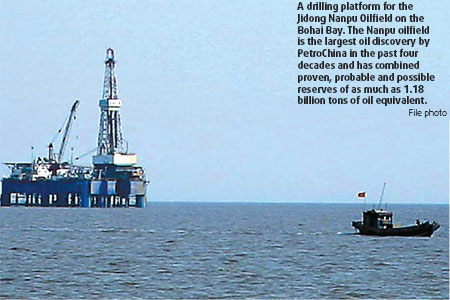A treasure trove called Bohai Bay
Updated: 2007-09-07 06:31

It is highly possible that offshore areas in Bohai Bay will yield further crude reserves as more exploration projects are scheduled this year, a source from China's largest oil company has said.
"Based on the current data available, it is almost certain that offshore areas of Bohai Bay will surpass the onshore region in oil reserves," says Shi Lin, president of China National Petroleum Offshore Engineering Co Ltd (CPOE).
What Shi predicts has already proved to be true as the nation's top resources watchdog confirmed recently that PetroChina's Jidong Nanpu Oilfield in Bohai Bay has more reserves than estimated, which is a shot in the arm for both the company and the country's energy security as a whole.
Jidong Nanpu Oilfield, the largest oil discovery by PetroChina in the past four decades, has combined proven, probable and possible reserves of as much as 1.18 billion tons of oil equivalent, the Ministry of Land and Resources has confirmed.
China National Petroleum Corporation (CNPC), PetroChina's parent company, announced in May that the newly found Jidong Nanpu Oilfield has a reserve of 1 billion tons, or about 7.35 billion barrels, the largest discovery in the country in four decades.
"We are making it a priority to further explore the offshore potential of Nanpu Oilfield," Shi from CPOE adds.
"Our research demonstrates offshore areas in Bohai Bay are richer than the onshore sector in crude reserves. After further tapping the Nanpu block, we will switch our attention to other offshore blocks around Bohai Bay, such as Jinzhou and Panjin, this year," Shi adds.
According to the CPOE boss, onshore areas around Bohai Bay have a proven annual production capacity equal to that of the Daqing Oilfield.
CPOE is a subsidiary of CNPC, the country's top oil firm, entrusted with offshore oil and gas exploration and production.
By 2012, CNPC expects the Nanpu Oilfield to produce 10 million tons of crude yearly, with 7 million tons from offshore platforms, according to Hu Wenrui, vice-president of PetroChina, CNPC's Hong Kong- and New York-listed arm.
Zhai Guangming, a noted geologist with the Chinese Academy of Engineering and the first general manger of the Jidong Oilfield, expects more discoveries from Bohai Bay following the Nanpu block, based on estimates that there are 29 billion tons of oil in the region. Zhai projects that half of the potential has not yet been tapped in Bohai Bay. Shi from CPOE agrees, citing recent discoveries by PetroChina and China National Offshore Oil Corp (CNOOC).
China's top offshore oil and gas company CNOOC says it also expects "a cluster of quality oil and gas fields" to be discovered in Bohai Bay, which will become a "major driving force" for the firm's future output. The offshore oil producer says its exploration efforts there are in full swing.
Earlier this year, CNOOC announced a find in Bohai Bay that had a test output of 1,600 barrels of oil and about 10 million cubic feet of gas per day.
PetroChina's new oilfield lies in the Nanpu block of CNPC's Jidong Oilfield in Caofeidian in Tangshan, in North China's Hebei Province. The Nanpu block, partly offshore, covers 1,300-1,500 square kilometers and is expected to produce light crude.
Nanpu Oilfield has four oil-bearing geological structures, PetroChina discovered through drilling, which have combined reserves of 1.18 billion tons of oil equivalent.
The proven reserves of the oilfield stand at 445 million tons of oil equivalent, according to certification of the Ministry of Land and Resources.
It is possible that even more reserves will be found at Nanpu Oilfield and in Bohai Bay as a whole as new exploration technologies and theories are adopted, says Han Xuegong, a senior consultant with CNPC.
"The reserves at Daqing Oilfield were thought to be 2.2 billion tons, but it eventually turned out be to 5 billion. I reckon Bohai Bay is similar to Daqing Oilfield in terms of reserve potential," Han says.
China's older oilfields such as Daqing are yielding less crude year-on-year though Daqing remains the top oilfield operated by PetroChina.
The discovery in Bohai Bay has been a shot in the arm for both PetroChina's business performance and China's energy supply as a whole, Han says.
Liu Gu, a veteran analyst with Shenzhen-based Guotai Jun'an Securities (Hong Kong) Ltd, says: "Our projections show that with the new discovery, the firm's projected 2009 output will increase by 6.9 percent - and that is a conservative figure."
PetroChina's proven developed and undeveloped reserves as of December 31 reached more than 20.5 billion barrels of oil equivalent, according to the firm's 2006 annual report. The newly discovered 7.35 billion barrels at Nanpu Oilfield will increase the firm's reserves by more than one-third.
"This is a really big boost due to the fact that most of PetroChina's profit stems from upstream oil and gas production," says Yin Xiaodong, an oil analyst at CITIC Securities Co.
(China Daily 09/07/2007 page42)
|
|
|
||
|
||
|
|
|
|